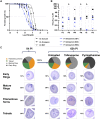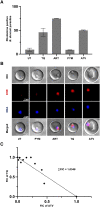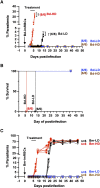Tafenoquine-Atovaquone Combination Achieves Radical Cure and Confers Sterile Immunity in Experimental Models of Human Babesiosis
- PMID: 38169301
- PMCID: PMC10786256
- DOI: 10.1093/infdis/jiad315
Tafenoquine-Atovaquone Combination Achieves Radical Cure and Confers Sterile Immunity in Experimental Models of Human Babesiosis
Abstract
Human babesiosis is a potentially fatal tick-borne disease caused by intraerythrocytic Babesia parasites. The emergence of resistance to recommended therapies highlights the need for new and more effective treatments. Here we demonstrate that the 8-aminoquinoline antimalarial drug tafenoquine inhibits the growth of different Babesia species in vitro, is highly effective against Babesia microti and Babesia duncani in mice and protects animals from lethal infection caused by atovaquone-sensitive and -resistant B. duncani strains. We further show that a combination of tafenoquine and atovaquone achieves cure with no recrudescence in both models of human babesiosis. Interestingly, elimination of B. duncani infection in animals following drug treatment also confers immunity to subsequent challenge. Altogether, the data demonstrate superior efficacy of tafenoquine plus atovaquone combination over current therapies for the treatment of human babesiosis and highlight its potential in providing protective immunity against Babesia following parasite clearance.
Keywords: Babesia MO1; Babesia divergens; Babesia duncani; Babesia microti; Plasmodium falciparum; erythrocyte; human babesiosis; parasite; sterile immunity; tafenoquine.
© The Author(s) 2024. Published by Oxford University Press on behalf of Infectious Diseases Society of America. All rights reserved. For permissions, please e-mail: journals.permissions@oup.com.
Conflict of interest statement
Potential conflicts of interest. All authors: No reported conflicts of interest. All authors have submitted the ICMJE Form for Disclosure of Potential Conflicts of Interest. Conflicts that the editors consider relevant to the content of the manuscript have been disclosed.
Figures







References
-
- Kjemtrup AM, Conrad PA. Human babesiosis: an emerging tick-borne disease. Int J Parasitol 2000; 30:1323–37. - PubMed
-
- Krause PJ. Human babesiosis. Int J Parasitol 2019; 49:165–74. - PubMed
-
- Krause PJ, Daily J, Telford SR, Vannier E, Lantos P, Spielman A. Shared features in the pathobiology of babesiosis and malaria. Trends Parasitol 2007; 23:605–10. - PubMed
Publication types
MeSH terms
Substances
Grants and funding
LinkOut - more resources
Full Text Sources

